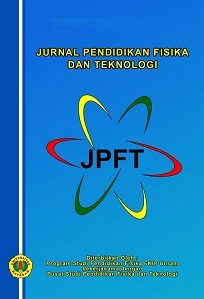Pengaruh Model Pembelajaran Berbasis Masalah Berbantuan Mobile Pocket Book Fisika Terhadap Kemampuan Pemecahan Masalah Peserta Didik
DOI:
10.29303/jpft.v5i2.1163Published:
2019-11-18Issue:
Vol. 5 No. 2 (2019): Juli-DesemberKeywords:
Problem Based Learning, Mobile Pocket Book, Problem Solving AbilityArticles
Downloads
How to Cite
Downloads
Metrics
Abstract
This study aims to determine the effect of problem-based learning models assisted by pocket book physics on problem-solving abilities. The type of research used was quasi-experimental design with pretest-posttest control group design. The population in this study were all students of class X MIPA Senior High School in Mataram. The research sample was taken using cluster random sampling technique, so that the selected students of class X MIPA five were 31 people as the experimental class and the X class MIPA six as many as 27 people as the control class. The experimental class was treated in the form of a problem-based learning model assisted by pocket book physics mobile and the control class was treated in the form of conventional learning. The instrument used to measure problem solving ability is a test instrument in the form of a descriptive test of five items. The research hypothesis was tested using the t-test with a significance level of 5%. The t-test produces a t-count value of problem solving ability of 5.832 which is smaller than ÃÂ which is equal to 2.003 so that H0 is rejected and Ha is accepted. So it can be concluded that there is the influence of the problem-based learning model assisted by pocket book physics on students' problem solving abilities. This result can be proven by the N-gain test, where there is an increase in problem solving abilities of 60% for the experimental class and the control class by 34% with the medium category.References
Amanah, P. D., Harjono, A., & Gunada, I. W. (2017). Kemampuan Pemecahan Masalah Dalam Fisika Dengan Pembelajaran Generatif Berbantuan Scaffolding dan Advance Organizer. Jurnal Pendidikan Fisika dan Teknologi, 3(1), 84-91.
Abdani, R. 2018. Pengaruh Pendekatan Berpikir Kausalitik Ber-Scaffolding dengan Pemberian Tugas Pendahuluan Terhadap Kemampuan Pemecahan Masalah Impuls Dan Momentum Peserta Didik Kelas X (Doctoral dissertation, Universitas Mataram).
Aziz, A., Rokhmat, J., & Kosim, K. 2017. Pengaruh Model Pembelajaran Berbasis Masalah dengan Metode Eksperimen Terhadap Hasil Belajar Fisika Siswa Kelas X SMAN 1 Gunungsari Kabupaten Lombok Barat Tahun Pelajaran 2014/2015. Jurnal Pendidikan Fisika dan Teknologi, 1(3), 200-204.
Embong, A. M., Noor, A. M., Hashim, H. M., Ali, R. M., & Shaari, Z. H. (2012). E-Books as Textbooks in the Classroom. Procedia-Social and Behavioral Sciences, 47, 1802-1809.
Gunawan, G. 2017. Keterampilan Berpikir dalam Pembelajaran Sains. Mataram: Arga Puji Press.
Gunawan, G., Harjono, A., & Sutrio, S. (2017). Multimedia Interaktif dalam Pembelajaran Konsep Listrik bagi Calon Guru. Jurnal Pendidikan Fisika dan Teknologi, 1(1), 9-14.
Hastuti, A., Sahidu, H., & Gunawan, G. (2017). Pengaruh Model PBL Berbantuan Media Virtual Tehadap Kemampuan Pemecahan Masalah Fisika. Jurnal Pendidikan Fisika dan Teknologi, 2(3), 129-135.
Hermansyah, H., Gunawan, G., & Herayanti, L. (2017). Pengaruh penggunaan laboratorium virtual terhadap penguasaan konsep dan kemampuan berpikir kreatif siswa pada materi getaran dan gelombang. Jurnal Pendidikan Fisika dan Teknologi, 1(2), 97-102.
Khumaidi, A., & Sucahyo, I. 2018. Pengembangan Mobile Pocket Book Fisika Sebagai Media Pembelajaran Berbasis Android pada Materi Momentum Dan Impuls. Inovasi Pendidikan Fisika, 7(2).
Landau, R. H., Paez, M. J., Bordeianu, C., & Haerer, S. 2011. Making physics education more relevant and accessible via computation and eTextBooks. Computer Physics Communications, 182(9), 2071-2075.
Niami, K., Kosim, K., & Gunawan, G. 2018. Model Problem Based Learning Berbantuan Simulasi Komputer Untuk Meningkatkan Penguasaan Konsep Pada Materi Alat-Alat Optik. Jurnal Pendidikan Fisika dan Teknologi, 4(2), 220-225.
Ngalimun. 2014. Strategi dan Model Pembelajaran. Yogyakarta: Aswaja Pessindo.
Rokhmat, J. 2013. Peningkatan Kemampuan Pemecahan Masalah Mahasiswa Calon Guru Fisika melalui Berpikir Kausalitas dan Analitik. Disertasi. Universitas Pendidikan Indonesia: tidak diterbitkan.
Rokhmat, J., Rusdiana, D., Setiawan, A.. 2012. Pembelajaran Fisika Berbasis Proses Berpikir Kausalitas Dan Berpikir Analitik (PBK-BA), Suatu Pembiasaan Berpikir Secara Terbuka. Seminar Nasional IX Pendidikan Biologi FKIP UNS.
Saavedra, A. R. and Opfer, V. D. 2012. Teaching and Learning 21st Century Skills (Global Cities Education Network Report (Asia Society)). Hongkong: RAND Coorporation.
Seng Tan, O. 2009. Problem Based Learning and Creativity. Singapore: Cengage Learnig Asia Pte Ltd.
Tamami, F., Rokhmat, J., & Gunada, I. W. 2017. Pengaruh Pendekatan Berpikir Kausalitik Scaffolding Tipe 2a Modifikasi Berbantuan LKS Terhadap Kemampuan Pemecahan Masalah Optik Geometri Dan Kreativitas Siswa Kelas XI SMAN 1 Mataram. Jurnal Pendidikan Fisika dan Teknologi, 3(1), 76-83.
Author Biographies
Rindayu Noviatika, Pendidikan Fisika, Universitas Mataram
Gunawan Gunawan, Pendidikan Fisika, universitas Mataram
Joni Rokhmat, Pendidikan Fisika, Universitas Mataram
License
Authors who publish with Jurnal Pendidikan Fisika dan Teknologi (JPFT) agree to the following terms:
- Authors retain copyright and grant the journal right of first publication with the work simultaneously licensed under a Creative Commons Attribution License 4.0 International License (CC-BY-SA License). This license allows authors to use all articles, data sets, graphics, and appendices in data mining applications, search engines, web sites, blogs, and other platforms by providing an appropriate reference. The journal allows the author(s) to hold the copyright without restrictions and will retain publishing rights without restrictions.
- Authors are able to enter into separate, additional contractual arrangements for the non-exclusive distribution of the journal's published version of the work (e.g., post it to an institutional repository or publish it in a book), with an acknowledgement of its initial publication in Jurnal Pendidikan Fisika dan Teknologi (JPFT).
- Authors are permitted and encouraged to post their work online (e.g., in institutional repositories or on their website) prior to and during the submission process, as it can lead to productive exchanges, as well as earlier and greater citation of published work (See The Effect of Open Access).











